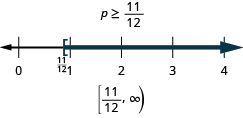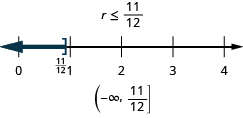| << Chapter < Page | Chapter >> Page > |
The inequality means all numbers less than or equal to 1. There is no lower end to those numbers. We write in interval notation as . The symbol is read as ‘negative infinity’. [link] shows both the number line and interval notation.


Did you notice how the parenthesis or bracket in the interval notation matches the symbol at the endpoint of the arrow? These relationships are shown in [link] .

Graph on the number line and write in interval notation.
ⓐ ⓑ ⓒ
 | |
| Shade to the right of , and put a bracket at . |
 |
| Write in interval notation. |
 |
 | |
| Shade to the left of , and put a parenthesis at . |
 |
| Write in interval notation. |
 |
 | |
| Shade to the left of , and put a bracket at . |
 |
| Write in interval notation. |
 |
Graph on the number line and write in interval notation:
ⓐ ⓑ ⓒ



Graph on the number line and write in interval notation:
ⓐ ⓑ ⓒ



The Subtraction and Addition Properties of Equality state that if two quantities are equal, when we add or subtract the same amount from both quantities, the results will be equal.
Similar properties hold true for inequalities.
| For example, we know that −4 is less than 2. |
 |
| If we subtract 5 from both quantities, is the
left side still less than the right side? |
 |
| We get −9 on the left and −3 on the right. |
 |
| And we know −9 is less than −3. |
 |
| The inequality sign stayed the same. |
Similarly we could show that the inequality also stays the same for addition.
This leads us to the Subtraction and Addition Properties of Inequality.
We use these properties to solve inequalities, taking the same steps we used to solve equations. Solving the inequality , the steps would look like this:
Any number greater than 4 is a solution to this inequality.
Solve the inequality , graph the solution on the number line, and write the solution in interval notation.
 | |
| Add to both sides of the inequality. |
 |
| Simplify. |
 |
| Graph the solution on the number line. |
 |
| Write the solution in interval notation. |
 |
Solve the inequality, graph the solution on the number line, and write the solution in interval notation.

Solve the inequality, graph the solution on the number line, and write the solution in interval notation.

The Division and Multiplication Properties of Equality state that if two quantities are equal, when we divide or multiply both quantities by the same amount, the results will also be equal (provided we don’t divide by 0).

Notification Switch
Would you like to follow the 'Elementary algebra' conversation and receive update notifications?